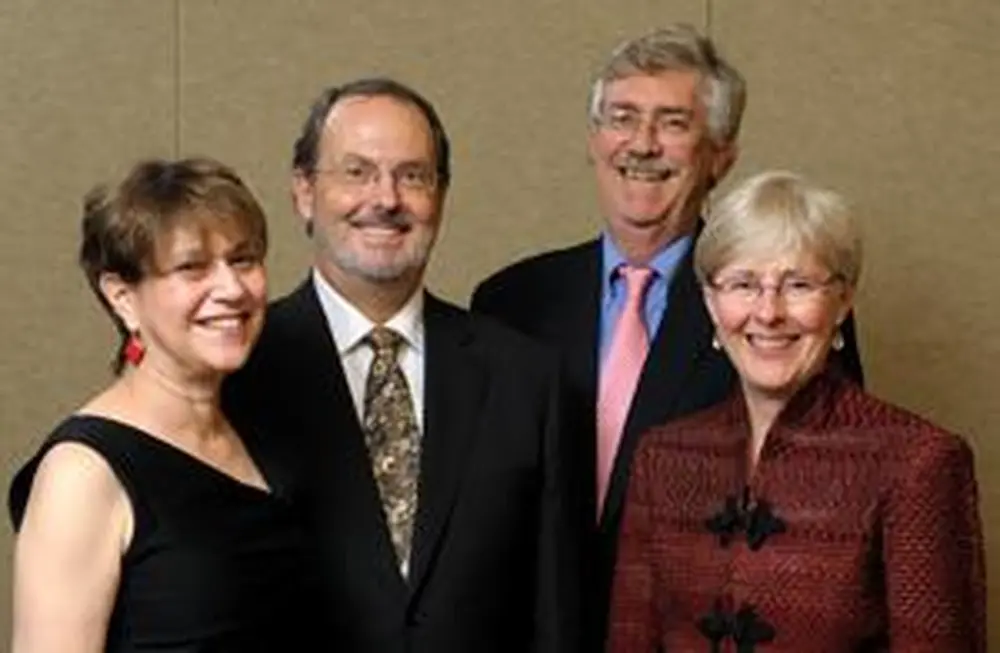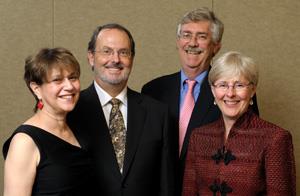

Four LAS alums have each been recognized for his or her body of work—a full career of groundbreaking achievements. But in 2009, a common thread runs throughout these bodies of work—and that is the human body itself. Each of the winners of the 2009 LAS Alumni Achievement Award has delved into the mysteries of the body, from genetics to disease to the human brain.
Over 135,000 LAS alumni have the opportunity to nominate their choices for this prestigious award each year. We are proud to present your 2009 honorees.
Bearing Witness
Myra Bluebond-Langner, AM ’71, PhD ’75, anthropology
“You once told me you wanted to be a doctor,” the physician told her 6-year-old patient. But the boy lashed back, throwing an empty syringe at her. “I’m not going to be anything!”
When the attending nurse asked what he was going to be then, the boy replied, “A ghost.” Then he turned over in the hospital bed and looked away.
This 6-year-old knew he was dying of leukemia—one of many heart-wrenching cases from The Private Lives of Dying Children, the landmark book by Myra Bluebond-Langner. The patient’s story was also one of many cases illustrating the extent to which dying children are aware of their illnesses.
Bluebond-Langner, an anthropologist at Rutgers University since 1974, is nationally known for her work with seriously ill children, which began while pursuing her PhD in anthropology at the University of Illinois. In fact, her PhD thesis became The Private Lives of Dying Children.
Back then, she says, many had the misconception that young children were not fully aware that they were dying. Her work was the first to shatter that myth.
Bluebond-Langner is also known for breaking free from professional jargon in her writings. For instance, much of the material in The Private Lives of Dying Children is presented in the format of a play.
“I was interested in finding a way to immerse the reader in the experience of what it was like for these children,” she says.
Bluebond-Langner has continued this innovative approach throughout her career, such as in her second book, In the Shadow of Illness, which presents portraits of families with children suffering from cystic fibrosis.
She also founded the Center for Children and Childhood Studies, and she founded and edits the Rutgers University Press Book Series in Childhood Studies—the first multidisciplinary book series in childhood studies.
Throughout it all, Bluebond-Langner is often asked how she can handle such a difficult subject as dying children.
“The difficulty stems from a sense of obligation to get it right, to make sure that their voices are heard,” she says. “I have the burden of making sure that my bearing of witness is right.”
The Greatest Challenge
Lynn Hartmann, AB ’70, English
In 1983, Lynn Hartmann was trying to choose a medical specialty—a decision that would set the course for the rest of her life.
“I remember seeing a woman with cancer who had already gone through treatment A and treatment B and treatment C, and I’m thinking, ‘This poor soul. What am I going to find when I enter her room?’” Hartmann recalls. “But I found a very peaceful, very calm, very caring individual who was interested in me. My stereotype was not at all on par with who she was.”
This woman, and others like her, inspired Hartmann to enter oncology with a specialty in women’s cancers. Today, she is one of the nation’s leading experts in breast and ovarian cancer. She is a professor of oncology at the Mayo Clinic College of Medicine, co-leader of the Mayo Women’s Cancer Program, and associate director of education for the Mayo Clinic Cancer Center.
Hartmann, an LAS alumnus in English, says she is especially excited about the type of discoveries that have clinical applications. Ten years ago, for example, Hartmann and her team found that prophylactic mastectomy prevented over 90 percent of breast cancers for women with hereditary risk. The procedure has since been covered by insurance companies.
Today, Hartmann is working on better ways to predict who is at risk of developing breast cancer. Specifically, she has been finding ways to save and study breast tissue removed from women who previously had benign breast biopsies.
“The ability to view a tissue at risk gives the most reliable information about future cancer risk,” she says. “So there’s really rich information in these breast tissue samples.”
Most recently, Hartmann was named director of Mayo’s new ovarian cancer research program, which will initially explore four new treatment methods—the most novel project being one that uses the measles virus to combat cancer.
“What keeps me fresh after all of these years,” she says, “is being part of the future, so that five years from now we’re not offering the same methods of diagnosis and treatment. What also keeps me fresh is that I’m still meeting patients who absolutely take my breath away.”
“Outrageous” Innovation
Brock Siegel, PhD ’74, chemistry
Brock Siegel still remembers the 1998 meeting where it all began. What started out as a typical budget meeting at Applied Biosystems suddenly took a dramatic turn when the CEO suggested that they could map all of the genes in the human body in about 16 to 20 months.
“The room went silent,” Siegel recalls. “We could see immediately that the impossible task of sequencing the human genome was in fact possible.”
Siegel, a New York native and LAS chemistry alum, has been at the center of the genetic engineering revolution for most of his career, and was even honored to have 13 tubes of his own blood used as a small part of the first mapped Celera Human Genome.
Siegel started his industry career with the Henkel Corporation in California, where he helped develop enzymes for detergents—one of the earliest commercial uses for genetic engineering. After a stint with Millipore, a major developer of tools for DNA analysis, he joined Applied Biosystems, whose automated gene-sequencing machine became the largest-selling analytical instrument in the world. Siegel’s role was making sure that the chemistry worked in the instrument.
When Applied Biosystems and its sister company, Celera Genomics, decided they could map all of the genes in the human body in 18 months for only $10 million, many thought it outrageous—but they pulled it off.
Since then, advances have continued to speed up the process. In 2006, Siegel joined Solexa, which mapped the human genome for about $50,000 in about one to two weeks. Today, he is involved in a new start-up company, which aims to map the human genome in one week for about $1,000.
For Siegel, the work still packs the same thrill as it did when he used his old chemistry set in his basement back in the 1950s.
“Turning a research notion, especially if it’s outrageous, into a reality is where the thrill and the excitement is,” he says. “It hasn’t changed.”
Autistic Expressions
Fred Volkmar, BS ’72, psychology
A camera, mounted on the boy’s baseball cap, pointed directly at his left eye, tracking eye movements as he watched an old movie. But something was different about this boy: he was watching the actors’ mouths or sometimes zeroing in on objects in the background. But he wasn’t focusing on the actors’ eyes, as most people do.
That’s because this boy was autistic—a developmental disorder that severely impairs social interactions, including eye-to-eye contact. The study, the first of its kind, was conducted by Fred Volkmar, LAS psychology alumnus and professor of child psychiatry at Yale University since 1982.
Volkmar also is an internationally recognized expert on autism. In 1994, he even served as primary author of the official medical definition of autism—an effort in which he coordinated over 100 clinicians as they studied about 1,000 cases from 20 different sites.
Autism is characterized by severe problems in social interaction, as well as by odd obsessions and mannerisms, such as body rocking or finger flicks, he says. Volkmar also discovered that when autistic children look at faces, they do not use the part of the brain typically triggered when a person looks at a face. Instead, they use the part of the brain that most people use to look at objects.
“This tells us that the wiring is fundamentally different,” Volkmar says. “Faces don’t have the same specialness to them. About 90 percent of the important information in a social interaction comes from looking at the top half of a person’s face. But when these children only look at the mouth, they miss out on a very substantial body of information.”
Volkmar also does research on related disorders, such as Asperger syndrome, and he has been director of the Yale Child Study Center since 2006. This interdisciplinary center studies all kinds of issues, including obsessive-compulsive disorders, Tourette syndrome, and autism.
“The exciting thing right now is that we’re on the threshold of being able to identify the genes behind autism,” he says. “It’s a very exciting time to be in autism research.”


